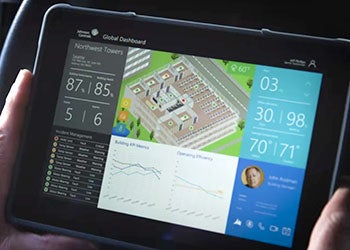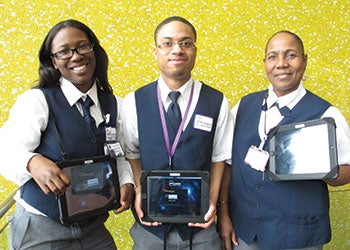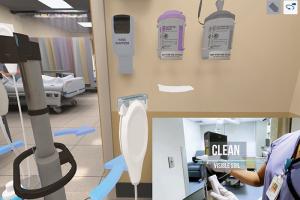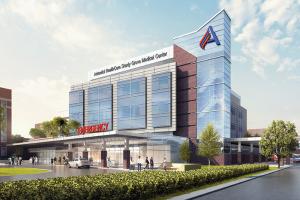Internet of Things transforms health facility operations
In the same way the internet vastly expanded the universe of information at people’s fingertips, the Internet of Things (IoT) — interconnected equipment and devices designed to collect and exchange data — is making previously inaccessible information readily available.
Health care organizations are using this technology to manage and maintain building systems; gather, analyze, store and share business, facility and patient data; track supplies, equipment, patients and staff to ensure they come together in the best possible way; and monitor patients’ health in a variety of settings. As the IoT advances, health care professionals are discovering new ways it can improve workflow, leading to better patient experiences and outcomes.
Also in this article |
| Medical devices keep off-site patients connected |
| Health care furniture gets technology boost |
|
|
The IoT has gained interest in the commercial market through products like Wi-Fi-enabled home appliances. “It’s nice that your fridge talks to your iPhone,” says Nader Mherabi, senior vice president, vice dean and chief information officer for NYU Langone Medical Center, New York City. “Your washing machine can tell you that it’s done. That’s all good.” But in health facilities, the IoT is much more relevant, creating efficiency, safety and value, and freeing people “to do more meaningful work, as opposed to taking data from one device and punching it into the next,” he says. In health care, says Mherabi, “there’s a very good case for the Internet of Things.”
Managing the environment
Given the newness of IoT, it’s perhaps not surprising that there’s still some vagueness about the concept. “There’s no well-defined meaning for the Internet of Things, whether it’s hosting all your data in the cloud or just making sure that one building system is talking to another building system,” says York Chan, CHFM, CHC, SASHE, administrator of facilities, Advocate Health Care, Downers Grove, Ill.

Smart Connected Chillers by Johnson Controls Inc., developed in collaboration with Microsoft Corp., connect central plant equipment to a cloud-based analytics platform.
Building automation systems (BASs) are nothing new in health facilities, but IoT connectivity greatly improves these systems’ abilities to collect, store, retrieve, analyze and communicate data. The Healthcare Environment Optimization system by Johnson Controls Inc., Milwaukee, integrates a hospital’s BAS and surgery scheduling software to automatically adjust and document operating room environmental controls in accordance with the surgical schedule, resulting in $6,000 average annual savings and increased operating room staff productivity.
The company’s Smart Connected Chillers, developed in collaboration with Microsoft Corp., Redmond, Wash., use Microsoft’s Azure IoT Suite to connect central plant equipment to a cloud-based analytics platform that provides information about equipment performance to on-site and off-site technicians via the web. This includes 24/7 alarm monitoring for system problems, as well as predictive diagnostics to head off potential maintenance issues. Johnson Controls has a complete line of smart HVAC equipment with these fault detection and diagnostics capabilities.
You may also like |
| Internet of Things impacts hospital facilities |
| Medical grade wireless to become necessity |
| Gigabit Wi-Fi opens medical device opportunities |
|
|
“The really new thing with the internet and building automation systems is the ability to track past performance,” Chan says. “Using the Internet of Things, they go back and look at past performance and say, ‘Hey, you’re using twice as much energy under the same conditions as a year ago; something is wrong.’ We would be able to make adjustments or repairs to get the system back to optimum performance, therefore saving energy and dollars. That’s helping us maintain our buildings in a better physical environment, to deliver an optimum physical environment for our patients.”
These historical data are also useful for accreditation purposes and for maintaining the safety of clinical equipment, Chan adds. “We are required to maintain temperatures and humidity parameters in certain areas of the hospital, such as operating rooms and the ICU. Smart building systems let us document all the calibrations and preventive maintenance to prove that the systems are meeting code requirements to the regulators.”
The operational efficiency provided by this technology is essential to health facilities today, says Chan. “None of us are getting any more staff,” he notes. “We’re right now probably maintaining twice as much square footage with half the FTEs that we had 15 years ago. So, a lot of the recordkeeping and the searching and the alarming and everything has saved us from having to do that manually, and that’s helping. We literally and absolutely have to rely on technology because we’re not going to get any more dollars for staffing.”
Investments in interoperability
The recent proliferation of equipment and devices that can communicate data prompted NYU Langone to create a technology review board comprising staff members from the bioengineering, facilities and information technology departments, as well as nurses and clinicians, to determine if new technologies under consideration integrate well with the hospital’s electronic health record (EHR) system and workflow. “Any new device we buy, we want to make sure it’s interoperable,” Mherabi says.
“These things are not easy,” he adds. The hospital recently standardized on one IV pump, which took a year to integrate into the EHR and existing workflow and is being deployed across the medical center. Now, when a doctor creates an order in the EHR for medication, Mherabi explains, these data are sent at the appropriate time to the pump; a nurse scans the patient’s bar code to identify the patient, then the data flow into the pump to program it. The nurse validates the data, as a quality check. This is faster and safer for patients (and less tedious for nurses) than having nurses enter the data directly, a process that can introduce errors, Mherabi says. “We’ve been very thoughtful about how we connect these things in a more meaningful way to electronic health records and the way people work,” he notes.

NYU Langone Medical Center reduced patient transport time by 40 percent since 2013 after implementing a program that enables staff to track patients and orders on minitablet computers.
Other IoT initiatives at NYU Langone include refrigerators that monitor their temperature and notify specified facilities staff, researchers or clinicians if the temperature is outside established parameters — a system that, with 700 to 800 refrigerators involved, took about six months to work out, operationally, Mherabi says. The medical center also uses a wireless equipment-tracking system and has implemented a patient transport program that enables staff to track patients and orders on minitablet computers. This latter program, which operates on a wireless infrastructure available throughout the hospital, even in elevators, has reduced patient transport time by 40 percent since 2013. On a couple of inpatient units, the hospital is piloting wireless, wearable technology for patients, which continually monitors their vital signs.
NYU Langone is building a new hospital that is scheduled to open in 2018. “There’s a lot of work to be done, and part of that is to create a smart environment, where everything talks to each other,” Mherabi says. Ensuring that the data-collection abilities of the facility can be put to meaningful use is a priority of the project team. “It’s great for research, for example, if a pump gives you a lot of data. But it’s not good if you don’t synthesize that data and make it meaningful,” he notes.
Asset tracking and system integration
Data from the integrated inventory management solution at BJC HealthCare, St. Louis, are providing unprecedented insights into the health system’s supply chain and its effect on patient care, according to Steve Kiewiet, vice president, supply chain operations. The solution, developed by Cardinal Health, Dublin, Ohio, tracks inventory using radio-frequency identification (RFID) technology.
As of May, there were 16 procedural areas using the solution, with implementation being rolled out in 20 more departments this year. Linkages are in place to interface with the health system’s clinical and enterprise resource systems, as well as its data analytics team. “We can now start using the data to truly understand not only demand and consumption, but even what we use in different types of cases,” says Kiewiet. “We’ve seen total pipeline inventory levels drop from the manufacturer, distributor and BJC. We’ve seen expired product write-offs go to almost zero.”

An auto-discharge process at Geisinger Wyoming Valley Medical Center begins when staff remove patients’ tracking bracelets and drop them into a box as they leave the unit, triggering an alert to environmental services staff.
Once a procedure room has been online for awhile, the solution begins to anticipate needs and make real-time par level recommendations. The solution also recognizes seasonal trends over time, like the need to stock up for flu season with the necessary supplies.
Recalled items are easily removed from the supply chain because their exact locations are known via RFID tags. The interface between the inventory management solution and clinical systems allows recalled items to be flagged in the clinical system, to prevent their use if they have already reached the point of care. “The patient safety aspect is awesome,” Kiewiet says.
As BJC works toward implementing EHRs systemwide, the inventory management solution’s implications for patient care are expanding. Once the solution is integrated with the EHR, “what kind of things could I start to learn about procedures and patient conditions and outcomes, and does product have any corollary play in that or not?” asks Kiewiet. “We now are seeing that there could be real value in having that data and using it in myriad places beyond just inventory management.”
Beaumont Health, Southfield, Mich., is seeking similar benefits from the integration of accounting, supply chain and computerized maintenance management systems. Beaumont Health was formed in 2014 through the merger of three southeast Michigan health care organizations. Jeffrey Gielniak, AIA, Beaumont’s system director for property and real estate management, and John Fragomeni, CBET, CHFM, system director of facilities management, jointly manage a division within the organization called Facilities, which oversees Beaumont’s construction development, real estate transactions and property management functions, as well as facilities management and biomedical engineering.
“Facilities is becoming more and more technology-driven, and integration to one platform within a new health care organization is critical for many different reasons,” says Fragomeni. “Resources are going in one direction and expectations are inversely proportional to that. So, how do we bridge that delta? We need to bridge it through technology.”
Fragomeni and Gielniak are looking into cloud-based solutions from Oracle Corp., Redwood City, Calif., with the goal of integrating Beaumont’s business and facility data seamlessly, so that it is accessible systemwide. “Then accounting can dig their information out of it, we can pull our information, and it’s all common and communal information,” says Gielniak. A common platform will encourage the consistent use of best practices across the system for greater efficiency, reduced costs and improved patient safety, he adds.
Follow the data
Geisinger Health System, Danville, Pa., uses real-time locating system (RTLS) technology by TeleTracking Technologies Inc., Pittsburgh, to track equipment, patients and staff in the organization’s facilities to improve workflow and patient outcomes. RTLS sensors and tags, provided by CenTrak, Newtown, Pa., placed on objects, patient wristbands and employee badges identify the location of each, enabling staff members to find, for example, the nearest piece of needed equipment or a specific patient who is ready for transport. The staff awareness and patient visibility components of the system add valuable information, says Seth Hostetler, lead process engineer, care support services, Geisinger.
The health system is using this information to examine patient, staff and equipment flows, with the aim of process improvement. An emergency department (ED) study at Geisinger Wyoming Valley Medical Center, Wilkes-Barre, Pa., linked nurse movement with patient information in the hospital’s EHR, allowing the health system to consider questions like, “If nurses always go to a supply closet to support patients with bone fractures, could these patients’ treatments be streamlined by pre-stocking certain supplies in an exam room?”
At a Geisinger outpatient clinic in the midst of an expansion project, tracking data is being used to improve workflows and resource allocation in the design of the new space. Five nursing units at Geisinger Medical Center, Danville, are undertaking a study to determine how much time nurses spend at the patient bedside, in an effort to increase direct patient care and decrease time spent gathering supplies and equipment. A future study is planned to track and analyze hand-hygiene compliance, to identify possible operational changes that support a minimal risk to the patient for health care-associated infections.
The CenTrak RTLS tags on patients’ tracking bracelets are also key to the automated discharge program in place at Geisinger. To start the auto-discharge process, hospital staff remove discharged patients’ tracking bracelets and drop them into a box as they leave the unit, triggering an immediate alert to environmental services staff that the room is ready to be cleaned for the next patient. According to Hostetler, environmental services is receiving this information about 40 minutes faster than before the auto-discharge program was implemented.
Hostetler envisions a future in which nursing units will receive automatic notifications when patients are admitted from the ED, so that nurses can greet their assigned patients at the elevator upon arrival at the unit. Tracking information also could be used to let family members know when patients will be back in their rooms following procedures, or to help make rounding more efficient for physicians and ancillary caregivers.
“Lots of different workflow improvements could make it a better experience for the patient,” he says. “And on the back end, now there’s such a rich set of data to mine to understand processes and what’s occurring. It’s a whole new visibility into areas where we just didn’t have visibility before.” HFM
Amy Eagle is a freelance writer based in Homewood, Ill., who specializes in health care-related topics. She is a regular contributor to Health Facilities Management.




